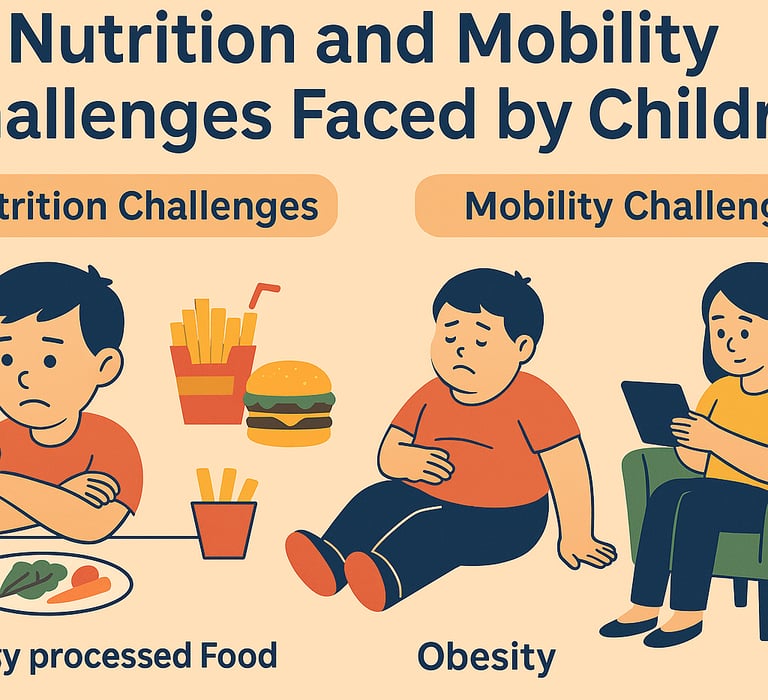Nutrition and Mobility Challenges Faced by Children: A Comprehensive Overview
Children today face a variety of challenges that impact their nutrition and physical mobility. These challenges can affect their growth, development, academic performance, and long-term health. Understanding these issues is the first step toward providing better care and support to children in our communities.
NUTRITION & MOBILITY
Ravisankar Lakshminarayanan
5/25/20252 min read


Mobility Challenges: Why Physical Activity Matters for Your Child
1. Sedentary Lifestyles Are Becoming the Norm
With increased screen time from smartphones, tablets, and computers, and pressure to perform academically, children spend less time playing outdoors or exercising. This leads to:
Weaker muscles and poor motor skills
Lower stamina and coordination
Increased chances of becoming overweight or obese
2. Poor Posture and Muscle Health
Many children develop poor posture due to prolonged sitting and use of gadgets. This can cause neck strain (“text neck”), back pain, and long-term spinal problems.
3. Limited Physical Education and Safe Play Areas
Not all schools provide enough physical education or safe playgrounds, which means fewer chances for children to move and play freely.
How Growing Income and Lifestyle Choices Affect Your Child’s Health
With higher incomes, families often buy more processed foods thinking it’s a sign of better living. However, this nutrition transition from traditional homemade meals to processed snacks is harming many children’s health, leading to:
Obesity and related health problems
Poor bone and muscle development
Vitamin deficiencies
In addition, modern lifestyles keep children indoors more than ever, which means:
Lack of sunlight exposure, leading to Vitamin D deficiency
Lower energy use due to less physical activity
Vitamin D deficiency can weaken bones and muscles, making children more prone to injury and illness. Combined with sedentary habits, this forms a cycle that leads to obesity and reduced mobility.
What You Can Do: Practical Tips for Parents
Nutrition Tips
Choose Whole, Protein- and Fiber-Rich Foods: Incorporate lean meats, legumes, nuts, seeds, whole grains, fresh fruits, and vegetables into your child’s diet.
Limit Sugary and Processed Foods: Treat processed snacks and fast food as occasional indulgences, not everyday staples.
Make Healthy Eating Fun: Get your child involved in shopping and cooking. Create colorful, tasty meals that appeal visually and taste-wise.
Hydrate Well: Encourage water over sugary drinks throughout the day.
Educate Yourself and Your Child: Learn about balanced diets and portion sizes. Teach children the benefits of eating well for their energy and growth.
Mobility and Lifestyle Tips
Encourage at Least 60 Minutes of Active Play Every Day: Activities like running, cycling, swimming, or even dancing can build strength and stamina.
Introduce Mobility Routines: Simple exercises such as soleus heel raises, yoga stretches, and breathing techniques improve muscle tone and flexibility.
Limit Screen Time: Set clear boundaries and encourage breaks for physical movement.
Promote Outdoor Play: Encourage regular safe sun exposure (about 10–15 minutes daily) to help Vitamin D synthesis.
Support Good Posture: Teach your child ergonomic sitting and screen habits to prevent strain.
When to Seek Professional Help
If your child shows signs of developmental delays, persistent mobility issues, or unusual nutritional problems, consult pediatricians or specialists early. Early intervention is key to managing any underlying conditions.
Final Thoughts: Your Role in Shaping Healthy Habits
As a parent, you are your child’s greatest advocate and role model. By fostering healthy eating habits and encouraging active lifestyles from a young age, you set the foundation for their physical, mental, and emotional well-being — today and into the future.
Remember: small consistent steps lead to big, lasting changes.
Follow us
platanoorganic6@gmail.com
+919019754079
© 2025. All rights reserved.
FSSAI License no : 21223192000415
Platano Organic Foods
